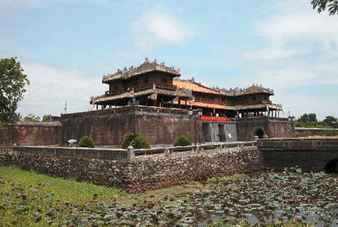Investigating Vietnam
Vietnam is a vast and beautiful country in Southeast Asia. Vietnam contains many unique geographical landmarks that are significant to its history. In order to fully understand how each landmark is unique, one must understand the history and territorial theories behind the country itself. Generally speaking, the Vietnam region is viewed as a division of 3 regions, the North, Middle, and South, each having its own unique geographical landmarks and its significant.

Lake of Sword (North Vietnam)
In the North, there are a lot of lakes. The history behind these lakes is when China (Ming Dynasty) tried to take over Vietnam; they must cross these great lakes in North Vietnam. One of the most famous lakes is the called
Ho Hoang Kiem meaning
The Lake of Sword. Stories tell us that a Vietnamese king once went to this lake, where he obtains a magical sword from a turtle. He used this sword to defeat the Chinese army and was able to force the Chinese out and stop them from invading Vietnam. This legend is very significant to the Vietnamese history because China has been Vietnam's enemy for long periods of time. This legend shows that the Vietnamese people are able to fight back the Chinese and not allow them to take over the Vietnamese land, since China and Vietnam are border-line in the North. Relating back to the lake, this lake is very sacred to the Vietnamese people because people once saw an old and very big tortoise, which they believe is the same 1000+ years old legendary tortoise that lives under this lake. Does this tortoise carry a sword in its mouth? No one actually knows. However, people who saw this tortoise believe it had something shinny in its mouth. In addition, the tortoise is one of the 4 sacred and legendary animals to the Vietnamese culture and its history.

Forbidden Purple City (Central Vietnam)
In the Central, one of the most famous places is called the City Hue, meaning "Royal City." The name is significant because this is where all the kings of Vietnam live. So when you go to Hue, you will see a lot of Chinese like and French like architectures of past kingdoms and palaces. The idea of Chinese influence is not a surprise since the origin of the Vietnamese people did come from southern China. However the Western influence is due to the colony of the French in Vietnam during the late 1800s and early 1900s. The French had a heavy influence in Vietnamese literature, art, and culture etc. For example, the
Forbidden Purple city (Tu Cam Thanh) is the third and the innermost fort of the royal complex. It has a perimeter of 1,225 meters and is accessible through seven gates. This was the place reserved for the private life of the kings and their families. The forbidden Purple City is almost isolated with the outside world.

Mekong River and Vietnam Countryside Setting (South Vietnam)
In the south, besides the inner city landmarks, South Vietnam is know for its vast lands that is good for agricultural and farming. The reason for this is because the Mekong Delta lies at the end of the country, making the soil very wet and good for planting rice paddies. People often visit the Mekong River because it is where all the fisherman and farmers work. It is a very nice place to be relaxed and enjoy the countryside of Vietnam, filled with animals, trees, and best of all fruits. South Vietnam is known for its diverse countryside provinces that are rich in agriculture, like
Long Xuyen, Can Tho, Ca Mao, etc.

Map of Vietnam
Relating to Image 5444, it is mostly covered up with clouds which make it hard to determine its actual location. This picture that was taken in January has a lot of clouds. An interesting fact is Vietnam does not have nice weather like we do in San Diego, it is extremely hot and humid in the Summer, and rains heavily creating floods in the fall and spring. During the beginning of the year, it rains heavily throughout Vietnam. But if it were to be on a clear day, you would be looking somewhere along the eastern part of Vietnam where the dark blue are ocean. From the map of Vietnam, it is connected to Thailand and other mainland in the North and Western region, where the south-east and eastern region are near the ocean. Vietnam is a beautiful country, with many diverse environments, and a unique culture.












